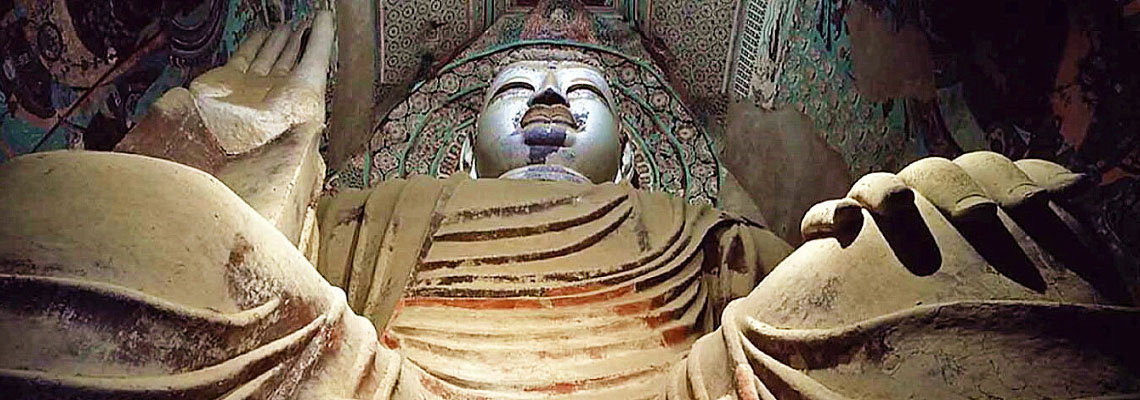
Day 1
BeijingPlease arrange for the international flight to get to Beijing. We will meet you at the Beijing airport, transfer you to the hotel and check you in, The rest of the day will be your free time to do a little exploration at you leisure.
Day 2
Beijing-

- Tiananmen Square
Today we will visit the Great Wall, Tiananmen Square, and the Forbidden City.
The Great Wall: This is one of the seven wonders of the world and the symbol of China. Badaling Great Wall, located 80km north-west of Beijing, is the most impressive and the most visited section of the Great Wall of China. Constructed in 1502 during the Ming Dynasty, the Badaling Great Wall once served as an important military fortification. Many leaders from China and around the world, like Richard Nixon, Margaret Thatcher, had all visited this section of the wall.
Tiananmen Square: Located at the centre of Beijing, Tiananmen, or the Gate of Heavenly Peace, is the largest city public square in the world. It was originally built in 1651 and in the 1950s it was enlarged to its current size, four times the original. It has great cultural significance as it was the site of a number of important events in the Chinese history, including the proclamation of the People’s Republic of China on October 1, 1949. It was named ‘Tiananmen Square’ because it is situated in front of the south gate of the Forbidden City - Tiananmen.
The Forbidden City: Located at the city center and called Gu Gong in Chinese, it was the imperial palace for twenty-four emperors during the Ming and Qing dynasties. It took 14 years to build during the reign of Emperor Chengzu in the Ming Dynasty (1368-1644). Ancient Chinese Astronomers believed that the Purple Star (Polaris) was in the center of heaven and the Heavenly Emperor lived in the Purple Palace. The Palace for the emperor on earth was so called the Purple City. It was forbidden to enter without special permission of the Emperor. Hence its name 'The Purple Forbidden City', usually just 'The Forbidden City’. Also called Palace Museum, the Forbidden City is recognized as the most magnificent and splendid palace complex in China and one of the five world-famous palaces, along with the Palace of Versailles in France, Buckingham Palace in England, the White House in United States, and the Kremlin in Russia.
Day 3
Beijing-

- The Ancient City Wall
In the morning you will take the flight to Xi'an. You're your arrival in Xian, we will visit the Shaanxi History Museum, Ancient City Wall, and the Grand Mosque.
Shaanxi History Museum: This provincial museum is one of the major museums in China. It holds numerous unearthed cultural artifacts from within the Shaanxi province as well as the rest of China. It covers 65,000 square meters, with a building area of 60,000 square meters. The newly built modern building recreates Tang-dynasty architecture and successfully symbolizes the great extent of Shaanxi history and its remarkable culture.
The Ancient City Wall: This is the most complete city wall that has survived in China as well being one of the largest ancient military defensive systems in the world. It was enlarged in Ming Dynasty (1368-1644) from the city wall initially built in Tang Dynasty (618 -907). Now it is 12 meters tall, 12-14 meters wide covering 14 kilometers in length with a deep moat surrounding it. The City Wall has corner towers, ramparts, sentry towers, gate towers, battlements and a number of city defensive fortifications with very strong defense capability. You can walk, even cycle on the wall. Its south gate is the largest with a suspension bridge. Most of the tourists choose the south gate for sightseeing.
Grand Mosque (and Old Muslim Quarter): The Grand Mosque is a Chinese traditional Alhambresque architecture with a long history and grand scale, and is a great combination of Islamic and Chinese culture. It was recorded that it was established in the first year of the Tian Bao reign by the Tang Dynasty Emperor Li Lung Ji (685AD-762AD). After renovations and expansions on several occasions in the Song, Yuan and especially the Ming and Qing Dynasties, it gradually took on the current appearance. The whole mosque has more than 12,000 square meters, the floor space more than 4,000 square meters. The construction is mostly in the Ming Dynasty style. The Mosque therefore has much Chinese traditional touch in both its design and artistic outlook. Besides the style peculiar to Islamic mosques, this Mosque also holds characteristics of Chinese pavilions with painted beams and engraved ridgepoles. The Grand Mosque and the Muslim Quarter are now an important cultural preservation of Shanxi Province and a national-level historical/cultural preservation site.
Day 4
Xi'an-
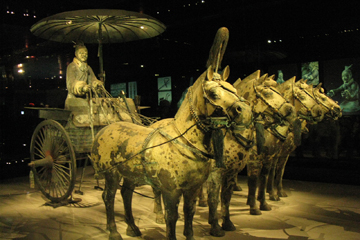
- The Terra-cotta Warriors and Horses
After breakfast we will visit the amazing Terra-cotta Warriors and Horses, where7000 individually crafted clay soldiers stand on guard. Then we will continue to the Bid Wild Goose Pagoda built to house Buddhist scriptures brought back from India during the Tang Dynasty, where you can see a variety of Buddha statues. After that we will send you to the train station to take the overnight train to Jiayuguan.
The Terra-cotta Warriors and Horses: This is one of the greatest archaeological findings of the 20th century - the army of terra-cotta warriors and the bronze chariots entombed in vast underground vaults at emperor Qin Shi Huang's tomb from two thousand years ago. It is a sight not to be missed by any visitor to China. Emperor Qin Shi Huang ascended to the throne of Qin at the age of 13 in 246 BC. Under him, Qin conquered the other six warring states and became the first true emperor, or Shi Huang, of China.
Big Wild Goose Pagoda: The Big Goose Pagoda is where the renowned Buddhist Master Xuanzang (Monk Tripitaka) stored his classics brought back all the way from India. The pagoda is one of the oldest structures in China. Originally it consisted of a brick structure of five storeys and was about 60 meters high. It was first built in 589AD during the Sui Dynasty. Between 701AD and 704AD during the reign of the Empress Wu Zetian five more storeys were added to the pagoda making it ten in all.
Day 5
Jiayuguan-

- The Jiayuguan Pass
Upon arrival at Jiayuguan, we will visit Jiayuguan Pass, The Great Wall on the Cliff, Great Walls Museum. After that we will head to Dunhuang.
Jiayuguan Pass: Jiayuguan Pass stands in the southwest part of Jiayuguan City, about 6 km away from downtown. The Ming Dynasty fort here guards the strategic pass, at the western end of the Great Wall – this was the last section built by the Ming Dynasty. Construction of the fort was started in 1372 in the Ming Dynasty, and subsequently enlarged and strengthened, and was known as 'the strongest pass under heaven'. It is located in the Jiayu Highland, hence its name Jiayuguan. It is situated between the Wenshu and Heishan Mountains at the foot of Jiayuguan Hill of the Qilian Mountain range.
The Great Wall on the Cliff: The Suspended Wall is a part of the Great Wall of China. The wall here was built on the ridge with a gradient of 45 degrees. It is high in the air and it looks as if it fell down from the top of the hill. So people refer to this section of the Great Wall as the "Suspended Wall". The Suspended Wall, the extension of the walls at the Jiayuguan Pass towards the north, was an integral part of the ancient defense system at the Jiayuguan Pass.
Great Wall Museum: The Great Wall museum opened to visitors in October 1989, and it is the first museum to exhibit the Great Wall culture in a comprehensive and systematic way. The Museum covers an area of 12,312 square meters with an exhibition area of about 1,766 square meters. Its main building takes a shape of a typical signal fire tower on the Great Wall.
Day 6
Dunhuang-
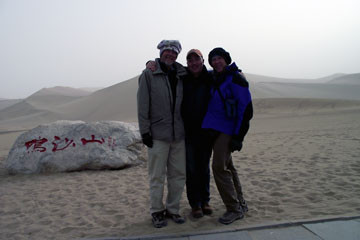
- Echoing Sand Mountain
After breakfast we will visit Mogao Grottoes, Echoing-Sand Mountain and Crescent Lake. You will then be transferred to the railway station to catch the train to Turpan.
Mogao Grottoes: The Mogao Grottoes, a shrine of Buddhist art treasures, is 25 km from downtown Dunhuang on the eastern slope of Mingsha Shan (Echoing Sand Mountain). A network of plank-reinforced roads plying north to south 1600 meters long lead to the cave openings, which are stacked five stories high, some reaching up to 50 meters. Incidentally, Mogao means high up in the desert. According to Tang Dynasty records, a monk had witnessed onsite a vision of thousand Buddhas under showers of golden rays. Thus inspired, he started the caves construction work that spanned a millennium, from the 4th to the 14th centuries. What remains today is truly awe inspiring, and is likely the world’s richest treasure house of Buddhist sutras, murals and sculptures. Please note that cameras are not allowed inside the grottoes.
Echoing-Sand Mountain and Crescent Lake: Together with the Crescent Spring and the Mogao Caves, the Echoing-Sand Mountain is the most popular tourist site in Dunhuang. Echoing-Sand Mountain, known as Mingsha Mountain to the Chinese, is 5 km to the south of Dunhuang and is famous for the constant sound of the moving sand. Legend has it that many years ago a horrific battle was fought here, and the sounds we hear today were the haunting cries of soldiers buried in the sand dunes. Situated within the Echoing-Sand Mountain Park, the Crescent Moon Lake is literally an oasis in the desert. The lake’s name derives from the crescent moon shape taken by the pool of spring water between two large sand dunes. Although the surrounding area is very dry, the pool surprisingly doesn’t dry up as one might expect.
Day 7
Turpan-

- Bezklik Grottoes
We will meet you at the train station, transfer you to the hotel and have you checked in. After that we will visit the Bezklik Grottoes, Astana Tombs, Tuyoq Valley.
Bezeklik Grottoes: The Bezeklik Grottoes, or Thousand Buddha Caves, is a complex of Buddhist cave grottos dating from the 5th to 14th century between the cities of Turpan and Shanshan at the north-east of the Taklamakan Desert near the ancient ruins of Gaochang in the Mutou Valley. They are high on the cliffs of the west Mutou Valley under the Flaming Mountains, and most of the surviving caves date from the West Uyghur kingdom around the 10th to 13th centuries. There are 77 rock-cut caves at the site. Most have rectangular spaces with rounded arch ceilings often divided into four sections, each with a mural of the Buddha. The effect is of entire ceiling covers with hundreds of Buddha murals. Some murals show a large Buddha surrounded by other figures, including Turks, Indians and Europeans. Some of the murals are masterpieces of religious art.
Astana Tombs: This is the graveyard of the residents who lived in the Gaochang City in the Jin-Tang period. Between 1959 and 1975, a great number of cultural relics had been unearthed, including Chinese documents, textiles, epitaphs, coins, clay sculptures, pottery, wooden wares, silk-paintings, crops and foods, etc. The site is known as the Underground Museum.
Tuyoq Valley: This is a 12 km long primitive Uighur agricultural valley about 70 km from Turpan, with vineyards and fields in the northern and southern valleys and a narrow ravine that connects them. It is a Muslim religious pilgrimage site. The southern mouth of the valley has big Uighur mosques older than the Sugong Minaret and a cave thought by many to be described in the Koran. About a kilometer from the cave shrine is a group of grottoes that have some Buddhist and Nestorian artwork. These grottoes are said to date from the West Jin Dynasty (265AD-316AD), and are considered to be the earliest in Turpan. Most of the murals are damaged. Fortunately, 10 of the grottoes still have some of the preserved murals. These precious murals are very unique in style.
Day 8
Turpan-

- Karez Irrigation System
In the morning we will visit the Jiaohe Ruins, Karez Irrigation system, and the Sugong Minaret. Then we will head to Urumqi.
Jiaohe Ancient City Ruins: The city's name means 'River City'. It was founded during the first century BC and abandoned during the 15th century. It is located atop a steep cliff on a leaf-shaped plateau between two deep river valleys in the Yarnaz valley 10 km to the west of Turpan City. It runs northwest to southeast, 1760 meters long and 300 meters across at the widest part. The ruins include city gates, streets and lanes, government office, temples, domestic houses, cave houses, wells, and an underground temple. It is part of the UNESCO World Heritage Silk Road Sites.
Karez Irrigation System: The ancient Karez Irrigation System, which is still used today, is a unique irrigation system in Turpan. It takes advantage of the slopes, draws the underground water to flow by itself to irrigate farmland. It consists of four parts: vertical wells, underground channels, ground canals, and small reservoirs.
Sugong Minaret: Located in Mura Village 2km to the east of the city of Turpan, the minaret tower was built in the 41st year of the long reign of Qianlong Emperor during the Qing Dynasty. It is the embodiment of the ancient architectural arts of the Uighur people. The body of the tower is cylindroid in shape, built with bricks arranged in various symmetrical patterns on the outer wall. The tower has 14 windows and a spiral staircase inside going to the top.
Day 9
Urumqi-
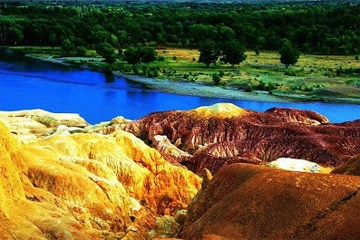
- Burqin Colorful Beach
After breakfast we will head to the Takashiken Border. We will be able to see the Burqin Colorful Beach and the Huoshao (Burnt) Mountain on the way. We might be able to see wild goats and wild donkeys if we are lucky.
Burqin Colorful Beach: Burqin Colorful Beach actually refers to the banks of a river that has desert, oasis and forest on its south side while sand/rock mounds in all shapes formed by years of wind erosion, line the north bank. The mounds have very irregular profiles and although they are mainly red, bands of red, white, black and yellow are also found in them
Day 10
Takashiken Border-
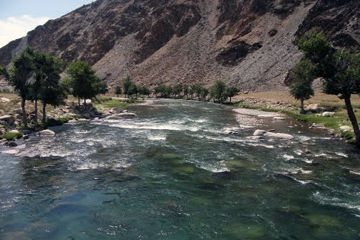
- The Bulgan River
In the morning we will travel to the border. We will be crossing the Chinese and Mongolian border before noon. Mongolian guides and drivers will pick up the group at the Mongolian border, bring you a mobile Ger (a Mongolian round tent) where you stay overnight. Along the way you will enjoy the mountain torrents surrounded by scenic nature, see the Canyon of the Altai Mountain range and huge 520kg stone which had been set up by a famous wrestler. You will arrive to Bulgan Soum in late afternoon. Our mobile Ger camp locates near the Bulgan River and between the border of Bayan Olgii and Khovd provinces. You will be welcomed by unique Uriankhai hospitality. Uriankhai is one of ethnic groups of Mongolia. They offer unconventional home-made special dairy products.
The Bulgan River rises on the southern slopes of the Mongol Altai mountain range and flows into Ulungur Lake in China. The site comprises a section of the Bulgan River valley, where the river divides into numerous large and small streams creating islands and isolated water bodies. At the source of the river and in the valleys of its tributary rivers, there are a number of small lakes. The sides of the Bulgan River valley support desert-steppe vegetation, while good wet riparian habitat is found along the bottom of the valley.
Day 11
Bulgan soum
After breakfast we will head to Uujim valley at Sagsai county where our events are being held. We will arrive late in the afternoon. Here we will visit Kazak families, who are famous by their century old tradition in the training of golden eagles.
Kazak Families: The Kazak Gers are slightly larger than Mongolian Gers, and are decorated with brightly colored rugs. We will enjoy their hospitality and friendliness and learn more about their culture. You will see their traditional technology in the making of colorful rugs. In the evening we will be served the highlight of the day, "bisparmak", which are real Kazakh dishes prepared for respected guests!
Day 12
Rest DayThis day is fully dedicated for resting, and your preparation for next days’ contests. Dinner will be special pasta. We will stay overnight in Ger at mobile camp.
Day 13
Golden Eagle Festival-
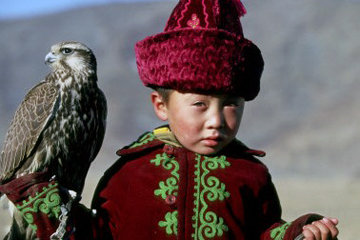
- The Golden Eagle Festival
Today and the next day we will enjoy "The Golden Eagle Festival". At about 11.00am the Opening ceremony of the festival commences as the participants join the parade on horse ride with their eagles. The competition begins with each Kazakh displaying his hunting outfit and accessories. The most elaborate and beautiful clothing and accessories are given the highest points. In the afternoon, the Golden Eagles will be evaluated for their speed and agility. In the evening we will watch a Kazakh concert consisting of traditional songs and dances.
Day 14
Golden Eagle Festival-
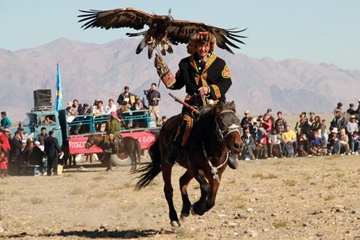
- Golden Eagle Festival
Prepare for some exciting action today! The Golden Eagles will be released from a cliff to attack fox skins that will be dragged by their owner on horseback. The eagles will be judged on their success in grabbing the "fox", their speed, and "gripping" technique. As the points for the competitions are being tallied, the Kazakhs will compete in their traditional game called "kekbar"- passing goat skin which tests one's horse riding skills, strength and agility. In the late afternoon, the winners of the festival will be announced at the awards ceremony. In the evening, we will enjoy a celebration dinner.
Day 15
Bayan Ulgii
After breakfast we will drive back to Ulgii town. You will be transferred to the domestic airport to take a flight to Ulaanbaatar. You guide will meet you at the airport and transfer you to the hotel to check in.
Ulaanbaatar is the capital and by far the largest city of Mongolia. An independent municipality, the city is not part of any province, and its population as of 2008 is over one million. Located in north central Mongolia, the city lies at an elevation of about 1,310 metres (4,300 ft) in a valley on the Tuul River. It is the cultural, industrial, and financial heart of the country. It is the centre of Mongolia's road network, and is connected by rail to both the Trans-Siberian Railway in Russia and the Chinese railway system.
Day 16
Ulaanbaatar-
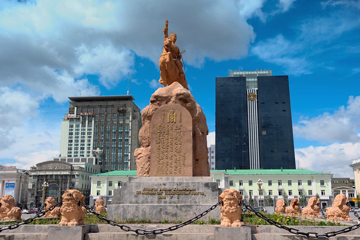
- Sukhbaatar Square
We will take the city tour, and enjoy watching a cultural show performance by “Tumen Ekh” national song, throat singing, tsam mask dance and so on. We will visit Sukhbaatar Square, the central square named after the revolutionary hero of 1921 Damdiny Sukhbaatar who declared independence from China. We will visit Gandan Monastery, the largest and most famous functioning monastery in Mongolia. Time permitting we will visit the Natural History Museum which is famous for its authentic dinosaur skeletons. We will visit Zaisan memorial hill where we will be able to take in a view of the whole city.
Sukhbaatar Square: Sukhbaatar Square is located in the center of Ulaanbaatar city. It is a big square. The Communist government had rallies and parades there. There is a statue of Damdin Sukhbaatar who led the 1921 revolution. He is portrayed as sitting on a horse. There is a big statue of Genghis Khan who is seated on a chair. Genghis Khan is portrayed as being very big, wide and heavy. The statue of Sukhbaatar is in front of the Saaral Ordon building. On the square, you can see the clean lines of the Parliament Building where Mongolia’s republican government has sessions
Ganden Monastery: Located in the center of Ulaanbaatar city, Ganden Monastery is the biggest temple in Mongolia. It was built in 1809, the14th year of Emperor Jiajing's reign During the Qing Dynasty. The predecessor of Ulaanbaatar city, Big Cullen, developed to a town on the basis of Ganden Monastery.
Day 17
Ulaanbaatar Your destinationAfter breakfast we will transfer you to the airport and take the flight to your destination.
| Travel in party of |
Superior Class ★★★★★ |
Deluxe Class ★★★★ |
Tourist Class ★★★ |
| 2-5 persons | N | $ | $ |
| 6-9 persons | N | $ | $ |
| 10 persons & above | N | $ | $ |
| Single room Supplement | N | $ | $ |
Service included:
√ Meals as listed in the itinerary, B=breakfast; L=lunch
√ Personal Guide & Driver + Private car / van for Private Transfers & sightseeing
√ Hotels with breakfast(twin share bases) as listed in the itinerary
√ Domestic flights or trains as listed in the itinerar
√ Airport Taxes: US$30for domestic
√ Service Charge & Government Taxes
√ Luggage Transfers between airports and hotels
√ Goverment letter for visa support
Service excluded:
* Personal expenses, tips to the guide and driver.
* Note, the price for 6-10 pax included Lunches and Dinners

